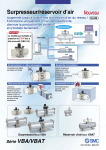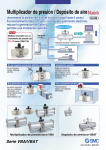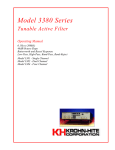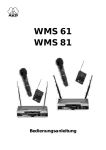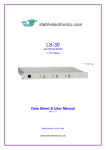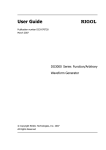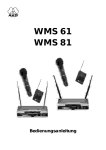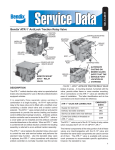Download Model 511 Operators Manual
Transcript
Model 511 10 ppm Precision DC Source/ Calibrator Operating Manual. Model 511 10 ppm Precision DC Source/ Calibrator Operating Manual Unit 4 15 Jonathan Drive, Brockton, MA 02301-5566 Tel: (508) 580-1660, Fax: (508) 583-8989 www.krohn-hite.com, e-mail [email protected] Printed in U.S.A. Version 1.05 Revised April 2003 Copyright © 2003 Krohn-Hite Corporation All rights reserved. No part of this publication may be reproduced, stored in a retrieval system or transmitted in any form by any means, electronic, mechanical photocopying, recording, or otherwise, without the prior written permission of Krohn-Hite Corporation Information furnished in this manual is believed to be accurate and reliable. However, no responsibility is assumed by Krohn-Hite Corporation for its use; nor for any infringements of patents or other rights of third parties which may result from its use. Table of Contents Section 1 Title General Description and Specifications................................................................... 1-1 1-1. 1-2. 1-3. 1-4. 1-5. 1-6. 1-7. 1-8. 1-9. 1-10. 2 Introduction ............................................................................................... 1-1 Description ................................................................................................ 1-1 Safety Information..................................................................................... 1-2 Krohn-Hite Contact Information ............................................................... 1-3 Factory Calibration.................................................................................... 1-3 Specifications ............................................................................................ 1-4 Output Specifications ............................................................................. 1-4 Secondary Performance Specifications .................................................. 1-4 General Specifications............................................................................ 1-5 Options ................................................................................................... 1-6 Operation ................................................................................................................... 2-1 2-1. 2-2 2-3 2-4 2-5 3 Page Introduction ............................................................................................... 2-1 Unpacking.................................................................................................. 2-1 Power Requirements.................................................................................. 2-2 Front Panel................................................................................................. 2-2 2-4-1 Front panel controls .................................................................. 2-2 2-4-2 Front panel indicators ................................................................ 2-3 2-4-3 Output Terminals ...................................................................... 2-3 Rear Panel.................................................................................................. 2-4 2-5-1 AC Power Entry Module ........................................................... 2-4 2-5-2 Optional Output Terminals ........................................................ 2-7 Incoming Acceptance ............................................................................................... 3-1 3-1. 3-2. 3-3. 3-4. 3-5. 3-6. 3-7. Introduction ............................................................................................... 3-1 Recommended Test Equipment.............................................................. 3-1 Warm-up Procedure................................................................................ 3-2 DC Voltage Verification Test.................................................................... 3-2 Optional Tests............................................................................................ 3-3 DC Voltage Load Regulation Test ......................................................... 3-3 DC Voltage Output Noise Test............................................................... 3-4 i Model 511 Operating Manual List of Illustrations Section 2 Title Operation ................................................................................................................... 2-1. 2-2. 2-3. 2-4. 2-5. 2-6. 3 Page 511 Front Panel View.................................................................................2-2 Front Output Terminals ..............................................................................2-3 511 Rear Panel View..................................................................................2-4 120 Volt Line Setting Example ..................................................................2-4 Power Entry Module Exploded View ........................................................2-6 Optional Rear Output Terminals ................................................................2-7 Incoming Acceptance ................................................................................................. 3-1. 3-2. Load Regulation Setup ...............................................................................3-3 Noise Check Setup .....................................................................................3-5 List of Tables Section 1 Title General Description and Specifications ................................................................... 1-1. 3 Output Specifications .................................................................................1-4 Incoming Acceptance ................................................................................................. 3-1. NOTE: Page Output Uncertainty Check..........................................................................3-2 Errata and addendum (if any) will appear in the back of this manual ii Section 1 Introduction and Specifications 1-1 Introduction This manual provides the user with the information needed to operate the Krohn-Hite Model 511. Section 3 is a procedure used to verify that the DC Calibrator is within the published specifications. Calibration information is included in the Krohn-Hite Model 511 Calibration manual. Details for contacting Krohn-Hite and important safety information are also contained within this manual. Note: If the Model 511 is still under warranty and it is outside its specified limits, contact Krohn-Hite or your distributor to establish the course of action. 1-2 Description The Model 511 DC Voltage Source / Calibrator is a highly versatile reference source, designed to meet the needs of computer systems, production line testing, QC and QA departments, design labs, and standards laboratories. The instrument has specified accuracies traceable to the U. S. National Institute of Standards and Technology. The Model 511 includes a "crowbar"or short circuit of the output and a true bipolar output stage that can be floated 500 volts from chassis. Output and sense terminals are gold plated, low thermal, safety, type, whose sense connection is selected via a front panel 2 wire - 4 wire sense switch, that negates the need for using cumbersome shorting links. Resolution of each range is 1 part per million. The instrument is a highly accurate reference that can be used for calibration of digital voltmeters, analog meters, semiconductor analyzing systems, analog references for computers, analog-to-digital converters, telemetry and data acquisition systems, and wherever a stable source is required. There are no adjustments made during normal operation. All adjustments are made during the factory calibration. The circuitry is completely solid state made of discrete, hybrid and/or integrated circuits packaged on etched glass circuit boards. These are proven circuits, using derated components to insure long life and maximum reliability. The instrument is overload and short-circuit protected, and is fully operational in normal environmental conditions. The 511 will drive a short circuit indefinitely without damage to the instrument, and will recover to rated specifications in less than 100µs. 1-1 Model 511 Operating Manual 1-3 Safety Information The Model 511 has been designed, tested and supplied in a safe condition. The following general safety precautions must be observed during all phases of operation, service, and repair. Failure to comply with these precautions or with specific warnings elsewhere in this manual violates safety standards of design, manufacture and intended use of this instrument. Krohn-Hite assumes no liability for the customer's failure to comply with these requirements. This manual contains information and warnings that must be observed to keep the instrument in a safe condition and ensure safe operation. Operation or service in conditions or in a manner other than specified could compromise safety. For the correct and safe use of this instrument, operating and service personnel must follow generally accepted safety procedures. To avoid injury or fire hazard, do not switch on the instrument if it is damaged or suspected to be faulty. Do not use the instrument in damp, wet, condensing, dusty or explosive gas environments. Whenever it is likely that safety protection has been impaired, make the instrument inoperative and secure against any unintended operation, and then inform qualified personnel. Safety protection is likely to be impaired if, for example, the instrument shows visible damage, or fails to operate normally. Ground the Instrument To minimize shock hazard, the instrument chassis and cabinet must be connected to an electrical ground. Any interruption of the protective ground conductor inside or outside the instrument is likely to make the instrument dangerous. Intentional interruption is prohibited. Do Not Operate In an Explosive Atmosphere Do not operate the instrument in the presence of flammable gases or fumes. Operation of any electrical instrument in such an environment constitutes a definite safety hazard. Keep Away From Live Circuits Operating personnel must not remove instrument covers. Qualified maintenance personnel must make component replacement and internal adjustments. Under certain conditions, dangerous voltages may exist. To avoid injuries, always disconnect input voltages before removing the covers. Use caution when working with voltages above 30 Vac rms, 42 V peak, or 60 Vdc. These voltages pose a shock hazard A good safety practice is to expect that hazardous voltage is present in any unknown circuit before measuring. 1-2 General Description and Specifications Safety Information Do Not Substitute Parts or Modify Instrument Because of the danger of introducing additional hazards, do not install substitute parts or perform any unauthorized modifications. Use only the replacement fuse(s) listed in this manual. Return the unit to the Krohn-Hite Service Department to modify or repair the instrument to ensure that safety features are maintained. Do Not Operate a Damaged Instrument Whenever it is possible that the safety protection features built into this instrument have been impaired, either through physical damage, excessive moisture, or any other reason, REMOVE the POWER and do not use the instrument until safe operation can be verified by service-trained personnel. If necessary, return the instrument to the Krohn-Hite Service Department for service and repair to ensure that the safety features are maintained. 1-4 Krohn-Hite Contact Information To order parts, accessories, or obtain service call: 1-508-580-1660 Or, visit the Krohn-Hite Web site at www.krohn-hite.com 1-5 Factory Calibration When manufactured, all 511’s are aged, calibrated and thoroughly verified with test equipment and calibration standards that are traceable to the U.S. National Bureau of Standards. Included with each shipment is a certificate of calibration. A performance verification procedure is provided in section three. This procedure can be used to make certain that the calibrator is with-in specifications. Verification is usually preformed when you first take delivery of the calibrator to make sure that there was no shipping damage, when you have questions about the calibrator’s accuracy, or after calibration Krohn-Hite Corporation recommends that the Model 511 be calibrated yearly at KrohnHite’s service center to sustain factory new performance. All calibrators returned to the factory for calibration have pre and post calibration data recorded. This allows a performance history file to be complied for each unit. Minor updates are installed (if any are available) during recalibration 1-3 Model 511 Operating Manual 1-6 Specifications Prior to shipment, the Model 511 calibrators are calibrated and data is recorded to guarantee that the unit is operating with-in specifications. Output Specifications listed below are absolute accuracies and are traceability to N.I.S.T. 1-7 Output Specifications The output uncertainty specifications apply after a one hour warm-up under standard reference conditions of 23ºC ± 1ºC and <70% relative humidity. Range Resolution (1ppm) Full Scale Absolute Accuracy (1 year) 100mV ±111.1110 mV 100 nV ±(10ppm of setting + 2µV) 1V ±1.111110 V 1 µV ±(10ppm of setting + 6µV) 10V ±11.11110 V 10 µV ±(10ppm of setting + 42µV) Table 1-1 Output Specifications Note: The specifications listed above are valid for one year calibration cycle. 1-8 Secondary Performance Specifications Stability:1 24 hrs, ± (2ppm of setting +1µV) Temperature Coefficient: 0º C to 10ºC, ± (3ppm of setting +2µV)/ºC 10º C to 40º C, ± (2ppm of setting +1µV)/ºC, typ ± 1ppm/ºC Noise and Ripple (0.1Hz to 100kHz): 100mV and 1V range, 5µV rms; typ < 3µV rms 10V range, 10µV rms; typ < 5µV rms Low Frequency Noise (0.1Hz to 10Hz): 2µV p-p. Maximum Load: 100mA all ranges. 1 Stability specifications apply after initial stabilization of one hour, constant ambient temperature ± 1ºC , constant line and load. 1-4 General Description and Specifications Secondary Performance Specifications Output Impedance: 10 µȍ. Line Regulation: ± (1ppm of range +1 µV) for a ± 10 % line fluctuation. Load Regulation: ± 1µV no load to full load. Settling Time: < than 100ms to settle to within 5ppm of final value. 1-9 General Specifications Calibration Interval: 1 year for 10ppm accuracy. Warm-up Time: 1 hour to rated accuracy. Output Isolation: Output may be floated 500V from chassis Power Requirements: 105-125 or 210-250 Volts ac, single phase, 50-400 Hz, 20 watts max. Temperature: Calibration Temperature: 23ºC ±1ºC Operating Limit: 0ºC to 50ºC 2 Storage Temperature: -40ºC to 85ºC Dimension: 3.5"(9cm) high, 14"(36cm) wide, 12.5"(32.1cm) deep. Weight: 12 lbs(5.4kg) net; 14 lbs(6.3kg) shipping. Certification: A Certificate of Compliance is issued with each new instrument to certify the calibration traceable to the National Institute of Standards and Technology (N.I.S.T.). 2 Accuracy is derated above 40º C due to loss of oven control. 1-5 Model 511 Operating Manual Warranty: Full one year warranty on parts and labor and a full one year warranty on specifications and performance. Extended warranty: Part No. EW511 provides an additional one year to the standard warranty 1-10 Options Rack Mount Kit: Part number RK-314 permits installation of the model 511 into a standard 19" rack. Rear Output Terminals: Option 003 provides both front and rear output terminals. Note that only one set of output terminals may be used at one time. CE Output Terminals: Option 004 Provides CE safety type output terminals. 1-6 Section 2 Operation 2-1 Introduction This section describes the basic operation of the Model 511. It includes the proper ac power requirements along with details of all operating modes and any special features. . ----- Warning ----The chassis of this instrument is connected to ground. For safety purposes, connect the line cord to a grounded 3-terminal ac outlet. The information in this section is intended only for qualified service personnel Do not attempt these procedures unless you are qualified to do so. ----- Caution ----Because of the potentially dangerous voltages that exist within the instrument, the covers of the Model 511 should not be removed when connected to an ac power source. The Model 511 is adjusted and checked carefully before shipment to ensure that the unit meets all specifications. It is aged and final tested to ensure that it is ready for use. The unit is shipped complete. 2-2 Unpacking Unpack the Model 511 carefully and inspect it for any damage that may have occurred during shipment. Check the case for damage, and check for loose sub-assemblies and parts. 2-1 Model 511 Operating Manual 2-3 Power Requirements The Model 511 is designed to operate from a single phase, 50-60Hz ac power source of 105V-132V or 210V-250V. The ac Power Entry Module, located on the rear panel, contains the main line fuse, an input line voltage selector, and an EMI filter. A detachable, 3-wire line cord is provided with the instrument. The 511 is normally shipped configured to the proper line voltage. To change settings, refer to section 2.5.1 for instructions. 2-4 Front Panel Figure 2.1 511 Front Panel View 2-4-1 Front Panel Controls Power switch: A two position switch supplies power to the Model 511. “Sense” Switch: This switch has two positions. In the "2 Wire" position, only the instrument's output terminals are connected, the sense terminals are connected to the output terminals internally. This position is used with high impedance loads. In the "4 Wire" position the user must connect both the sense and output terminals together at the load. This position is used to prevent "IR" wiring losses when drawing current. "Lo" switch: This switch has two positions. In the "Float" position the low output terminal is floating from chassis. In the "Chassis" position the low output terminal is connected to chassis ground. Decade Switches: There are six. Each one controls one decade of output magnitude, and is selectable from 0 to 10. Range Switch: A three position switch selecting one of the three voltage ranges: 100 mV, 1 V, or 10 V. 2-2 Operation Front Panel Controls Polarity Switch: This switch also has three positions. "+" polarity denotes that the red output terminal is positive with respect to black output terminal, and vice versa for "-" polarity. The "0" position produces a "crowbar" or short circuit "0" at the output terminals. 2-4-2 Front Panel Indicators Power On Indicator: The Green led is on whenever the 511 is plugged into an AC power source and the power switch is in the on position. Decimal Point Indicators: A "floating" decimal point is illuminated by several yellow LEDs and properly locates the decimal point for the range indicated. Overload Indicator: When illuminated, indicates an overload or possibly shorted condition (excessive current draw), or an open sense circuit condition. 2-4-3 Output Terminals Front Panel Connections: There are five terminals located on the front panel. All terminals are low thermal, gold plated type. Spacing is the standard 3/4" centers. Connections are located as follows: HIGH SENSE o m HIGH OUTPUT LOW SENSE o m LOW OUTPUT m CASE GROUND Figure 2.2 Front Output Terminals The "output" and "sense" refers to the 4-wire remote sense capability. This 4-wire system eliminates the IR drop and thus maintains the voltage accuracy, of the Model 511. NOTE: The "sense" circuit must be connected to the load when the 511 is used in 4-wire mode. 2-3 Model 511 Operating Manual 2-5 Rear Panel Figure 2.3 511 Rear Panel View 2-5-1 Power Entry Module The 511 will operate on 100, 120, 220 or 240 Vac line voltage. The following explain how to change the voltage settings and the fuse. The cover of the Power Entry Module shows four possible voltage settings (100V, 120V, 220V or 240V). Notice that a pin will be in one of these holes, indicating the present voltage setting for the 511. If this setting does not match the voltage available at your site, then it must be changed before powering on the 511. Figure 2.4 shows an example setting for 120 Vac operation. Figure 2.4 120 Volt Line Setting Example Follow the steps below to change a fuse or convert the operating voltage of a 511. 2-4 Operation Power Entry Module Set the 511 power switch to OFF. Unplug the power cord from the ac wall outlet and from the power cord receptacle on the power entry module. Refer to Figure 2-5 on the next page. Using a small flat blade screwdriver or similar tool inserted into the slot at the left edge of the cover, carefully pry the cover off the fuse cavity. To change the voltage setting, grasp the white plastic voltage select board pin and pull straight outward until the voltage select board unseats from the power entry module. Hold the board so that you can read the four voltage selection labels (100, 120, 220 and 240) imprinted on the board. Move the voltage indicator pin to the opposite side of the board from the desired voltage label. Be sure to seat the pin in the notch provided on the board's edge. Install the voltage select board so that it is fully seated in the voltage select cavity (the label side toward the fuse cavity). To change the fuse (s), remove the fuse (s) from the fuse carrier on the back of the cover. For 100 or 120 Vac operation, the fuse rating is 1/8 Amp, Slow-Blow. For 220 or 240 Vac operation, the fuse rating is 1/16 Amp, Slow-Blow. Be sure to use the correct rating for your voltage selection. For installation, insert the fuse(s) of the proper rating into the fuse carrier. To change the fuse arrangement to match that used in your country, remove the screw from the fuse carrier, remove the fuse carrier, turn the fuse carrier so that the desired fuse arrangement (single fuse or dual fuses) is facing outward, install the fuse carrier, and install the screw. For United States type power operation, use a single standard AGC or 3AG 0.25 inch x 1.25 inches fuse of the correct rating. For European type power operation, use two standard 5.2 mm x 20 mm fuses of the correct rating. For European use, is important to note that if your local electrical code does not allow a dual fuse arrangement, then a dummy fuse must be installed in the lower fuse carrier. Otherwise, the 511 will not operate. Place the cover on the power entry module and press inward until it snaps into place. Verify that the desired operating voltage is indicated with the voltage select board pin on the cover label. Connect the power cord to the power entry module and wall outlet. The Model 511 is now ready to be operated on the selected ac line voltage. 2-5 Model 511 Operating Manual Figure 2.5 Power Entry Module 2-6 Operation Optional Output terminals 2-5-2 Optional Output Terminals Rear Panel Connections: A factory installed option, there are five terminals located on the rear panel. The configuration is the same as the front panel terminals. Figure 2.6 below shows the connections. NOTE: Only one set of output terminals may be used at one time. o m HIGH SENSE o m LOW SENSE HIGH OUTPUT LOW OUTPUT CASE GROUND o Figure 2.6 Optional Rear Output Terminals 2-7 Model 511 Operating Manual Notes: 2-8 Section 3 Incoming Acceptance 3-1 Introduction The following procedure should be used to verify that the Model 511 is operating properly. These checks may be used for incoming acceptance and periodic performance checks. Test should be made with the covers in place and after a one hour warm-up under standard reference conditions of 23ºC ± 1ºC and <70% relative humidity. ----- Warning ----The chassis of this instrument is connected to ground. For safety purposes, connect the line cord to a grounded 3-terminal ac outlet. The information in this section is intended only for qualified service personnel Do not attempt these procedures unless you are qualified to do so. ----- Caution ----Because of the potentially dangerous voltages that exist within the instrument, the covers of the Model 511 should not be removed when connected to an ac power source. 3-2 Recommended Test Equipment The equipment listed below is required to perform the acceptance tests. Digital Voltmeter: H-P Model 3458A or equivalent. Power Load Resistor: CLAROSTAT Model 240-C or equivalent. High gain differential preamplifier such as PREAMBLE Model DA1822A or equivalent. True rms voltmeter having a 20mV range: Fluke Model 8920A or equivalent. 3-1 Model 511 Operating Manual 3-3 Warm-up Procedure Perform your verification measurements in a test environment that has a stable ambient room temperature with a relative humidity of less than 70% unless noted otherwise. The Model 511 requires a power line voltage of 100V, 120V, 220V, 240V, ±10% with a line frequency of 50Hz to 400Hz Allow the minimum warm up time for all test equipment. The Model 511 needs at least one hour to stabilize. Additional time will be needed if the instrument has been subjected to temperatures outside the 18-28°C range. 3-4 DC Voltage Verification Test After allowing sufficient warm up time, connect the DC voltmeter to the output terminals of the model 511. The front panel “SENSE” switch should be in the 2-wire position and the “LO” switch should be in the float positions. The chart below lists the 511 settings along with the test limits. Uncertainty Check Range 10V 1V 100mV D.P. LED on V 0.V mV Polarity Front Panel Decade Switch Setting Low Limit Upper Limit + 10 0 0 0 0 0 + 9.999858 V +10.000142 V - 10 0 0 0 0 0 - 9.999858 V -10.000142 V + or - 0 0 0 0 0 0 + 10 0 0 0 0 0 + 0.999984 V + 1.000016 V - 10 0 0 0 0 0 - 0.999984 V - 1.000016 V + or - 0 0 0 0 0 0 + 10 0 0 0 0 0 + 99.997 mV + 100.003 mV - 10 0 0 0 0 0 - 99.997 mV - 100.003 mV + or - 0 0 0 0 0 0 ± 42 µV ± 6 µV Table 3.1 Output Uncertainty Check 3-2 ± 2 µV Verification Optional Tests 3-5 Optional Tests These procedures are used to ensure that the Model 511 passes both the 4-wire load regulation and the output noise tests. 3-6 DC Voltage Load Regulation Test Connect the DC voltmeter to the sense and output junction on the Power Load Resistor box.3 Set the 511 to 4-wire mode and connect the load box to the 511 with two 2-wire twisted pair cables. The 511 sense and output terminals must be connected at the load box. Refer to figure 2.1 for hookup details. Load Box Model 511 SENSE OUT HI LO Voltmeter IN Figure 3-1 Load Regulation Setup Set the 511 to output 10.00000 volts and set the load box to a few hundred thousand ohms (light load). After noting the voltmeters reading, reduce the load resistance to 100 ohms and record the voltmeter new reading. The change should be less than ± 1µV. Change to the 1 V range and repeat the test using 10 ohms for the second setting. The change should be less than ± 1µV. Change to the 100 mV range and repeat the test using 1 ohms for the second setting. The change should be less than ± 1µV. 3 The voltmeter must be connected to the sense leads at the junction of where the 511's output and sense cables connect at the load. 3-3 Model 511 Operating Manual 3-7 Output Noise Test KH uses the following procedure to measure the noise levels of the voltage calibrator. Techniques are employed to minimize external ground loops and radiation paths that may introduce improper data into the desired measurements. "Rule of Thumb": If the measurement indicates more than 1 millivolt p-p of noise on any KH instrument, the operator should recheck his equipment, cables and connections. Noise may appear in many forms; therefore KH recommends the use of a true rms voltmeter with a 20mV range and a high gain (1000) differential pre-amplifier to make the noise measurements. The high gain differential pre-amplifier specified will increase the sensitivity of the true rms voltmeter, enabling it to resolve noise levels in the µV level. The noise test should not be made simultaneously with regulation and voltage accuracy test. The "feedback" currents from some measuring devices will seriously disturb noise measurements. Differential input measurements are the most reliable. They will cancel out common mode, due to slight errors in cable connections. The pre-amplifier, true rms voltmeter and the KH Calibrator under test should be connected to adjacent power outlets on the same phase. A three wire ground is required. In the event the line does not have a ground, the pre-amplifier and unit under test should have a separate, heavy wire chassis-to-chassis connection separate from the shield of the differential input leads. The lead used between the pre-amplifier input and the source output should be a shield, twisted pair with the shield connected to the frame of the preamplifier, and to the chassis ground terminal adjacent to the output terminals of the KH source. Do not use the shield of the input cable as the chassis-to-chassis connection in place of line system ground. Use additional separate heavy wire. Refer to Figure 2.2 on the next page for correct connections. 3-4 Verification Output Noise Tests Pre-amplifier Model 511 SENSE OUT + Input - Output CHASSIS Voltmeter IN Figure 3.2 Noise Check Setup Set the differential pre-amplifier upper frequency cutoff to100kHz and the lower cutoff to 0.1Hz. Set the model 511 “sense” switch to the “2-Wire” position and the output to zero. Connect the output of the pre-amplifier to the input of the true rms voltmeter. Observe that ripple and noise do not exceed specifications on each of the ranges. The limit is 5µV rms on both the 100mV and 1V range; and 10µV rms on the 10V range. NOTE: The "DC" mode on the preamp in use usually results in more accurate "noise" measurements. Be aware of the specifications for your preamp if this test is made at voltage levels other than zero, and AC input is used. 3-5 Model 511 Operating Manual Notes: 3-6



























